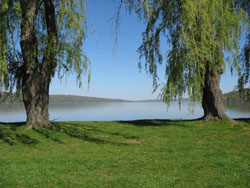Water Resources
 The Tompkins County Comprehensive Plan prioritizes the protection and preservation of water resources. The County aims to safeguard Cayuga Lake's ecological, economic, and recreational value, protect aquifers from contamination, and preserve stream health and wetland ecosystems. Additionally, the plan supports sustainable waterfront development while conserving natural resources and enhancing public access. For more details, please refer to the Water Resources Chapter(PDF, 8MB) of the Tompkins County Comprehensive Plan.
The Tompkins County Comprehensive Plan prioritizes the protection and preservation of water resources. The County aims to safeguard Cayuga Lake's ecological, economic, and recreational value, protect aquifers from contamination, and preserve stream health and wetland ecosystems. Additionally, the plan supports sustainable waterfront development while conserving natural resources and enhancing public access. For more details, please refer to the Water Resources Chapter(PDF, 8MB) of the Tompkins County Comprehensive Plan.
Six Mile Creek Study
Tompkins County wants to hear from residents near Six Mile Creek about their experiences with flooding, erosion, and water quality issues in the watershed.
Six Mile Creek is an important resource for drinking water, wildlife, and recreation. Tompkins County is working with local partners to better understand stream conditions and identify areas where improvements may help reduce erosion, flooding, and water quality issues. By sharing your input and what you have seen on or near your property, or within the greater watershed, you will help guide practical solutions that benefit both landowners and the wider community. This questionnaire is intended only to gather observations and ideas that will help shape future stream protection efforts. Thank you for taking a few minutes to share your knowledge and experience. Providing contact information at the end of the survey is optional.
If you have questions about the project or would like to receive a paper copy of the questionnaire, please contact Darby Kiley via email or at 607-274-5560.
Complete the questionnaire now: Six Mile Creek Study Questionnaire
Tompkins County Aquifer Program
In partnership with the United States Geological Survey (USGS), Tompkins County provides funding for an aquifer study program to help protect Tompkins County’s groundwater resources and drinking water supplies. County funds from this program leverage Federal funds to conduct consecutive studies of individual aquifers in the County. Participating municipalities also provide a portion of the necessary funding. The products of the studies are unique to each aquifer and generally include investigation of surface water and groundwater interaction, groundwater movement, and vulnerability of the respective groundwater resources. A list of completed studies can be found on our Wetland Mapping, Natural Resources Inventory, and Aquifer Studies section.
Tompkins County Harmful Algal Bloom Strategy
With an increase in harmful algal blooms (HABs, cyanobacteria) across New York, in 2018 Governor Cuomo allocated $65 million to address the issue. New York State HABs Action Plans were drafted for twelve priority waterbodies, including Cayuga and Owasco lakes. The challenge for agencies, municipalities, and watershed partners is to implement the priority projects in a meaningful way that safeguards water quality and reduces HABs.
The Tompkins County Harmful Algal Bloom Strategy(PDF, 140KB) focuses on actions to be undertaken in the next three years by Tompkins County departments and partners/agencies working in the county.
Wetland Mapping, Natural Resources Inventory, and Aquifer Studies